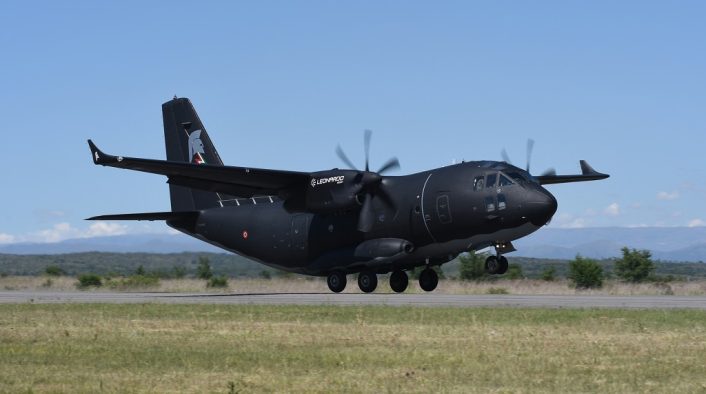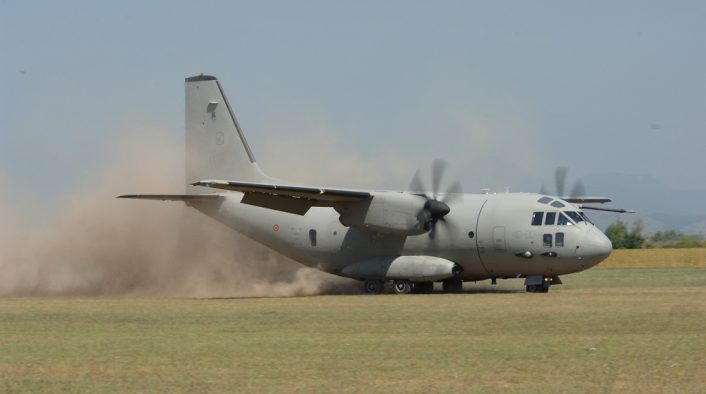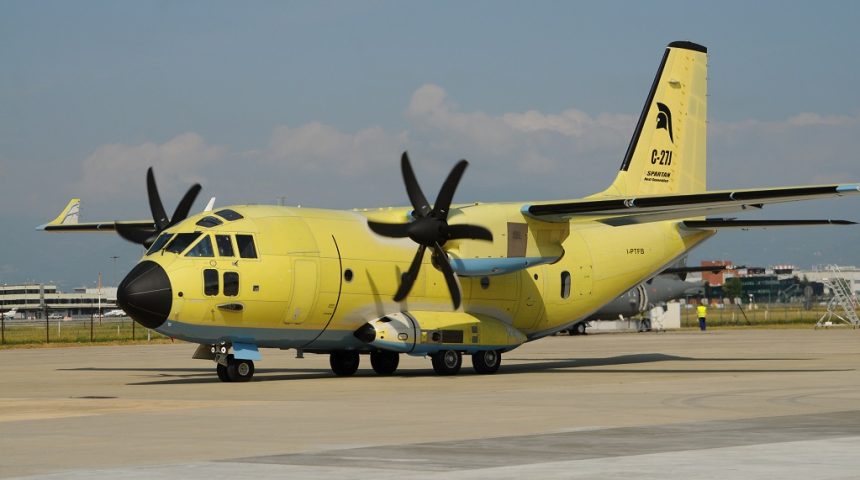Leonardo will begin the deliveries of the enhanced C-27J Spartan from 2021.
The Italian aerospace firm Leonardo recently announced that the C-27J Spartan Next Generation entered the final testing phase. 87 Spartans are currently in service or on order with 16 different operators all over the world and demonstrated the high performance and reliability of the aircraft in a wide range of missions, while also being highly interoperable with larger cargo aircraft (let’s not forget that the C-27J was designed to be interoperable with the larger C-130J and they both share many components, including the engines).
Marco Zoff, Leonardo Aircraft Division’s Managing Director, said: “The enhanced C-27J brings the unrivalled quality and capabilities of the Spartan to the next, higher level. Its operators will benefit from modern avionics, increased performance and efficiency. The Spartan embodies the essence of national security, proving to be the best asset for armed forces’ defence operations and for their fundamental contribution to population support and disaster relief.”
The improved aircraft features new equipment, avionics and aerodynamic devices, most notably new winglets, that are intended to boost even more the performance and reliability of the Spartan. The first aircraft in the new configuration will be delivered to an undisclosed customer in 2021, according to the company.
With the introduction of new equipment, new systems and aerodynamic solutions the #C27J Next Generation gained improved operating efficiency and enhanced performance. Find out more about its new features here: https://t.co/x6HOTr3ONQ pic.twitter.com/jNtEGPvGqU
— Leonardo Aircraft (@LDO_Aircraft) November 13, 2020
After the announcement about the C-27J Next Generation, Leonardo published on its website an interview with the company’s test pilot Matteo Maurizio, Head of Project Test Pilot Airlifters, Special Versions and UAS, who has been involved in the development of the new variant of the Spartan since its first test flights. Here is how he describes the improvements:
The main differences relate to the aircraft’s flying qualities and performance. In terms of quality, I must stress that the new state-of-the-art avionics technology fully complies with the most up-to-date international standard, called Performance Based Navigation and to have in the cockpit new features as FANS1/A+ Datalink, TCAS 7.1, ILS Cat II and Enhanced Video TAWS. This enables us to exploit all the capabilities offered by the operation in civil air spaces with no limitations and to enhance interoperability in tactical military scenarios with the integration of Mode 5 IFF/ADS-B out, tactical VNAV and Search and Rescue.
The new cockpit layout includes five new Colour Multipurpose Display Units – featuring new and enhanced LED lighting and panels that increase pilots’ efficiency during a flight – a dual redundant Flight Management System, two Digital Autopilot-Flight Director Systems with auto-throttle capabilities, and a comprehensive communications suite. For intra-theatre operations, these features, coupled with the many large cockpit windows typical of the Spartan, full cockpit compatibility with NVIS/NVG night vision systems and Head-Up Display availability help to minimise pilot workload while increasing the ability to manage the mission effectively in day, night and adverse weather conditions.
In terms of performance, the new winglets offer us several advantages in terms of aircraft controllability, in particular flying at slow speeds, as well as better payload capability also in hot and high conditions.
While its cruising speed of 325 KTAS (602 km/h) and service ceiling of 30,000 ft (9,144 m) will not change with the new configuration, the winglets will improve the aircraft’s climb capabilities in terms of climb gradients or MTOW of approximately 1,000 kg. This will allow us to operate from those airports with particularly steep climb gradients, which are normally served by four-engine aircraft.

The new Performance Based Navigation international standard, according to ICAO (International Civil Aviation Organization), “specifies that aircraft RNAV and RNP system performance requirements be defined in terms of the accuracy, integrity, continuity and functionality, which are needed for the proposed operations in the context of a particular airspace concept. The PBN concept represents a shift from sensor-based to performance-based navigation.”
PBN offers a number of advantages over the sensor-specific method of developing airspace and obstacle clearance criteria that is currently being replaced, reducing the need to maintain sensor-specific routes and procedures (and their associated costs) and the need to develop newer ones for new navigation systems, while allowing a more efficient use of the airspace (route placement, fuel efficiency and noise abatement), clarifying how RNAV and RNP systems (Area Navigation and Required Navigation Performance, two accurate methods of instrument navigation with many similarities) should be used, facilitating the operational approval process for operators by providing a limited set of navigation specifications intended for global use.
Un Combat Controller Team di Incursori del 17° Stormo simula l’esfiltrazione di connazionali da un’area di crisi, con atterraggio di un C-27J Spartan della 46ª Brigata Aerea su pista semipreparata del 9° Stormo #AeronauticaMilitare #latuasquadrachevola pic.twitter.com/trvKEQdJaG
— Aeronautica Militare (@ItalianAirForce) August 1, 2020
These navigation systems are accompanied by new systems to improve the already high safety standards of the Spartan (since the first flight in 1999, no crashes or major mishap have been reported, except for an inflight collision in 2014 between a USASOC C-27J and a USAF C-130H and a double tyre blow-out of a RAAF C-27J during a touch-and-go, both seemingly caused by human factors). Among those systems we can find FANS1/A+ Datalink, TCAS 7.1 and Enhanced Video TAWS.
FANS-1/A+ is a datalink which combines CPDLC and ADS-C to allow aircraft to be seen by ATC (Air Traffic Control) in areas where radar is not practical, so that a safe aircraft separation can be maintained. CPDLC (Controller Pilot Data Link Communications) is a two-way data-link system by which ATC can transmit non urgent strategic messages to an aircraft as an alternative to voice communications, and ADS-C (Automatic Dependent Surveillance-Contract) provides, again via a data link, data derived from on-board navigation systems, including aircraft identification, four-dimensional position and other additional data “on request”, instead of automatically as for more famous ADS-B.
TCAS II version 7.1 is the same Traffic Collision Avoidance System found on civilian airliners and other commercial aircraft and used to reduce the risk of mid-air collisions, while the Enhanced Video TAWS is an improved Terrain Awareness Warning System that uses a video camera in addition to radio altimeter readings and terrain closure rates to detect potentially hazardous terrain or obstacles, especially useful during low altitude flight.

Another system that has been mentioned is the IFF (Identification Friend or Foe) Mode 5, a militarized and encrypted variant of the civilian Mode S combined with ADS-B, which is mandatory for all NATO nations by 2020. According to Leonardo, this new baseline configuration is also offered as a retrofit to current operators willing to upgrade their C-27J fleet capabilities.
When asked about his experience with the Spartan and the aircraft’s behavior in operational conditions, Matteo Maurizio (which is also a former test pilot of the Italian Air Force Reparto Sperimentale Volo) said:
The Spartan is an excellent tactical airlifter for operational theatres. It displays great controllability in every flight condition, pilot’s situational awareness and external field of view, while the aircraft has high power engines. Collectively, these attributes are very important in the operational theatres. Furthermore, the Spartan has excellent maneuverability at low altitude, an essential characteristic for operating in full safety during marginal and critical conditions.
Compared with other military transport aircraft in its class, the C-27J has the best descent and climb rate, and can also perform 3g tactical manoeuvers, minimising its approach phase and reaching a safe altitude more quickly in high threat scenarios. Combining these elements with the self-defence system, DASS – which is available as an option and has already been adopted by several C-27J customers – provides the capability to perform evasive manoeuvers at low altitude, operate safely and exploit the terrain as protection against ground-based threats. Whatever the conditions, the Spartan is a forgiving aircraft, easy to pilot even at low speed and low altitude, and with generous stall performances for an aircraft of this class.
Speaking about humanitarian operations, I think the key phrase here is ‘autonomous operations’. The aircraft is equipped with an Auxiliary Power Unit (APU), which is fundamental for operations in unprepared and unequipped strips, or in situations where the ground support, for some reason, is unable to ensure its services.
The aircraft’s long range allows it to operate without the need to refuel at the airfield destination. Furthermore, for humanitarian operations, the C-27J is the only aircraft in its class with the capability to adjust the cargo floor, both in height and inclination, to facilitate the loading/unloading operations where no external support, such as a forklift or cargo loader, is available. Finally, since the Spartan is qualified to perform short take-offs and landings (STOL) on snowy, sandy and unprepared airfields, we can reach a wide range of airfields around the world, as we’ve done over many years.

In addition to the classic tactical transport and airdrop of troops and cargo, MEDEVAC/CASEVAC, humanitarian assistance and disaster relief support, the C-27J can perform also VIP transport, firefighting, ISR (Intelligence, Surveillance and Reconnaissance), Maritime Patrol and tactical support missions by using multiple roll-on/roll-off palletized mission kits and systems which allow a quick preparation for the new mission.
One of the configurations obtained with the use of the aforementioned kits is the MC-27J Praetorian, of which three are in service with the Italian Air Force to provide support for the Special Forces of the Comando Operativo Forze Speciali (COFS). To be more precise, the aircraft are three C-27J that were already in service and the ItAF repurposed with the addition of mission systems, C3ISR equipment and a palletized ATK GAU-23 30mm automatic cannon, the same used by the USAF AC-130J.
@GarethJennings3 @BarbaraBuzio @AleniaAermacchi @ATK with door plug pic.twitter.com/5UPASSQdOW
— Petru (@pietro_nurra) December 19, 2014
Another less known variant is the EC-27J JEDI (Jamming and Electronic Defense Instrumentation), modified to perform Electronic Warfare missions in support of ISAF operations in Afghanistan, where it flew for 2,800 hours from 2012 to 2014 across the whole country and prevented insurgents from using electronic devices to remotely detonate any Improvised Explosive Device (IED).









